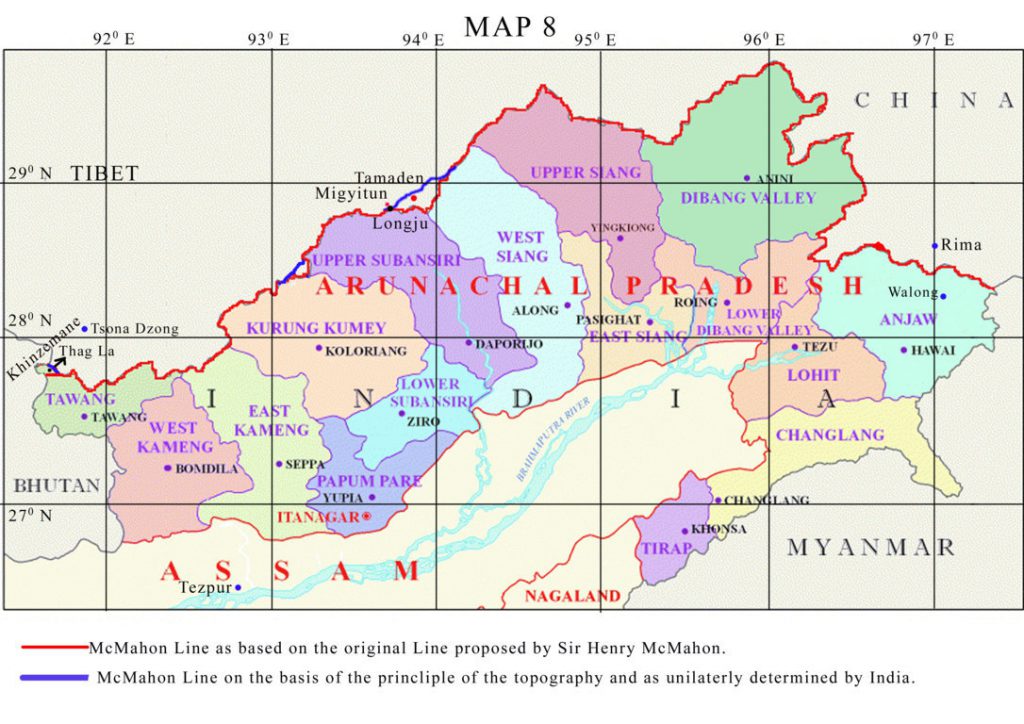On 8 September 1962, Chinese troops surrounded the Dhola Post near Tibet which India had set up in June 1962. The events that unfolded thereof led to the Indo-China war of 1962.
Aspirants would find this article very helpful while preparing for the IAS Exam.
| Be sure to check out the 100 Difference Between Articles for UPSC Revision now!!
To complement your preparation for the upcoming exam, check the following links:
|
Background of the Dhola Confrontation
- In June 1962, Indian troops had established an outpost at Dhola in the Namkha Chu valley that bordered the Thag La Ridge in Tibet.
- The McMahon Line was the agreed-upon border between Tibet and British India (as per the Simla Accord of 1914). India recognises this line as the border between India and China although China doesn’t recognise it saying Tibet was not a sovereign authority to enter into agreements.
- According to a treaty map of the Simla Accord, the McMahon Line lay at 27o45’40” N. The Indian government maintains that as per the agreement, the international border falls on the highest ridges of Thag La which was not at 27o45’40” N, and lay about 4 – 6 km north of the McMahon Line.
- The Dhola post lay about 6 km north of the McMahon Line.

- In August, China issued diplomatic protests arguing that India had ‘crossed’ the McMahon Line. At best, the Dhola-Thag La area is disputed.
- Chinese troops began occupying positions top of Thag La.
- On 8 September, 60 soldiers of the Chinese People’s Liberation Army (PLA) descended down the ridge and surrounded the Indian post at Dhola.
- For 12 days, there was no firing from either party.
- Since then, throughout September, there were firing and skirmishes between the two forces.
- By the month-end, the 7 Infantry Brigade was deployed on the Namka Chu and had been directed by the Indian Prime Minister, Jawaharlal Nehru to push back the Chinese out and secure the area. This operation was codenamed ‘Leghorn’.
- On 10 October, these 50 Indian troops were met by an emplaced Chinese position of some 1,000 soldiers. The Chinese troops opened fire on the Indians believing that the Indians had intruded upon Chinese land. The Indians were surrounded by Chinese positions that used mortar fire.
- However, they managed to hold off the first Chinese assault, inflicting heavy casualties. In the second assault, the Indians began their retreat, realising the situation was hopeless. The Indian patrol suffered 25 casualties, with the Chinese suffering 33.
- The Chinese troops held their fire as the Indians retreated, and then buried the Indian dead with military honours, as witnessed by the retreating soldiers. This was the first occurrence of heavy fighting in the war.
- It was a tough job for the Indian army as the terrain was difficult and the climate hostile, with the battlegrounds being more than 4000m above sea level in altitude.
- This attack had grave implications for India and Nehru tried to solve the issue, but by 18 October it was clear that the Chinese were preparing for an attack on India, with massive troop buildups on the border.
- From 20 October, the Chinese launched major offensives along the whole front, making an official beginning to the Sino-Indian war and claimed the act as one of self-defence. This war was fought over the disputed territories in Aksai Chin (Ladakh) and Arunachal Pradesh.
- The Aksai Chin area has been under the control of the Chinese ever since.
Also on this day
1952: The Universal Copyright Convention adopted in Geneva which was signed by 35 countries including India. 1960: Death of Feroze Gandhi, member of the Lok Sabha aged 47. 1982: Death of Sheikh Mohammad Abdullah, former Chief Minister of Kashmir aged 77. 1991: ULFA killed ONGC engineer T S Raju whom it had kidnapped, and an Amnesty International mediator Bipul Mahanta. 1993: Mandal Commission which recommended 27% reservation for the backward classes brought into effect, with the exclusion of the creamy layer.
See previous ‘This Day in History’ here.
For more information about the general pattern of the UPSC Exams, visit the UPSC Syllabus page. Candidates can also find additional UPSC preparation in the table below:
Related Links
Comments